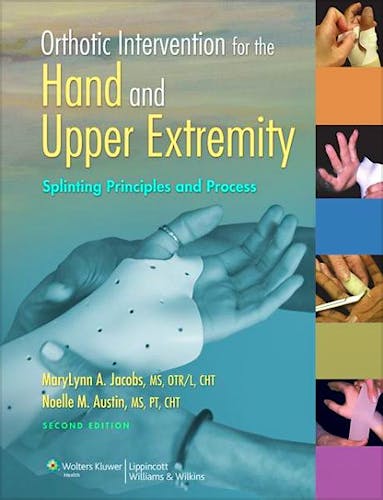

No hay productos en el carrito



Orthotic Intervention for the Hand and Upper Extremity. Splinting Principles and Process
Austin, N. — Jacobs, M.
2ª Edición Septiembre 2013
Inglés
Espiral
672 pags
1100 gr
22 x 28 x 3 cm
ISBN 9781451145304
Editorial WOLTERS KLUWER
Description
Prepare for your career as an occupation therapist with the expert information and easy-to-understand presentation in Orthotic Intervention for the Hand and Upper Extremity: Splinting Principles and Process, 2nd Edition. This proven book provides orthosis patterns for most upper extremity diagnoses and provides the information you need to make an informed decision about whether the best solution for a patient is to fabricate a thermoplastic or neoprene splint, or to cast, tape, or choose an over-the-counter solution.
This detailed and easy-to-use reference demonstrates splint fabrication techniques and related interventions, highlights anatomical and biomechanical principles, discusses associated indications and precautions, details common orthotic interventions, and provides an overview of popular taping methods.
- Master key concepts and skills with pattern descriptions and photographs for each intervention, along with “Clinical Pearls,” and “Pattern Pearls” that provide fabrication and orthosis modification tips, as well as insight for improving cost containment and maximizing time efficiency.
- Apply concepts to the clinical experience with case studies that stimulate clinical reasoning and help you synthesize text information.
- Find the information you need fast with lists of splints by name and by diagnosis in the index.
- See how research informs practice with evidence-based examples.
- Prepare for practice with consistent use of ASHT orthotics nomenclature throughout the book.
Features
- NEW! The book has been updated throughout with the latest information in the field, especially in Section II: Splint Fabrication
- NEW! Information on tissue healing has been added to each chapter.
- NEW! A new chapter covers the transplanted upper extremity and includes emerging concepts on post-operative management.
- NEW! In-text pedagogy includes chapter objectives, chapter review questions, and coverage of ASHT orthotics nomenclature.
- NEW! A powerful suite of online Instructor’s Resources has been added including an Image bank, “Clinic in the Classroom” PowerPoint slides; Sample Syllabi (for 1-day, 10-day, and 14-16 week sessions), exercises, answers to chapter review questions and discussion points, and case review questions and answers.
- NEW! Online resources to reinforce student learning include: Video Pearls that show the most common injuries/splints, an interactive quiz bank, online case studies, checklists, clinical forms, anatomy reference tables, a list of rehabilitation vendors, and references.
- Help your students master key concepts and skills with each chapter’s pattern descriptions with accompanying photographs, “Clinical Pearls,” and “Pattern Pearls” that include fabrication and orthosis modification tips, as well as insight for improving cost containment and maximizing time efficiency.
- Help your students apply concepts to the clinical experience with case studies that stimulate clinical reasoning and synthesize text information.
- Help your students find the information they need fast with the index that lists splints by name and by diagnosis.
- Show your students how research informs practice with evidence-based examples
- Prepare your students for practice with consistent use of ASHT orthotics nomenclature throughout the book.
- Prepare your students for clinical practice with information on specific diagnoses including stiffness, fractures, arthritis, tendon injuries, and peripheral nerve injuries.
- Provide the information your students need for working with diverse patient populations, including athletes, pediatric patients, and musicians, as well as patients with adult neurological dysfunction, burns, and a transplanted upper extremity.
- Help your students master key concepts and skills through Chapter Objectives,
Chapter Review Questions, and a comprehensive Glossary.
About the Author(s)
Table of contents
Contributors Clinical Pearls Introduction Section I—Fundamentals of Orthotic Fabrication CHAPTER 1 Concepts of Orthotic Fundamentals CHAPTER 2 Anatomical Principles CHAPTER 3 Tissue Healing CHAPTER 4 Mechanical Principles CHAPTER 5 Equipment and Materials CHAPTER 6 Fabrication Process Section II—Orthotic Fabrication CHAPTER 7 Immobilization Orthoses Part 1 • Digit- and Thumb-Based Orthoses Part 2 • Hand-Based Orthoses Part 3 • Forearm-Based Orthoses Part 4 • Arm-Based Orthoses CHAPTER 8 Mobilization Orthoses Part 1 • Digit- and Thumb-Based Orthoses Part 2 • Hand-Based Orthoses Part 3 • Forearm-Based Orthoses Part 4 • Arm-Based Orthoses CHAPTER 9 Restriction Orthoses Part 1 • Digit- and Thumb-Based Orthoses Part 2 • Hand-Based Orthoses Part 3 • Forearm-Based Orthose Part 4 • Arm-Based Orthoses CHAPTER 10 Nonarticular Orthoses Part 1 • Digit- and Thumb-Based Orthoses Part 2 • Hand-Based Orthoses Part 3 • Forearm-Based Orthoses Part 4 • Arm-Based Orthoses Section III—Optional Methods CHAPTER 11 Prefabricated Orthoses CHAPTER 12 Casting Techniques CHAPTER 13 Taping Techniques CHAPTER 14 Neoprene Orthoses Section IV—Orthotic Intervention for Specific Diagnoses and Populations CHAPTER 15 Stiffness CHAPTER 16 Fractures CHAPTER 17 Arthritis CHAPTER 18 Tendon Injuries CHAPTER 19 Peripheral Nerves Injuries CHAPTER 20 The Athlete CHAPTER 21 Adult Neurologic Dysfunction CHAPTER 22 The Pediatric Patient CHAPTER 23 Burns CHAPTER 24 The Musician CHAPTER 25 Hand and Upper Extremity Transplantation Index
© 2025 Axón Librería S.L.
2.149.0